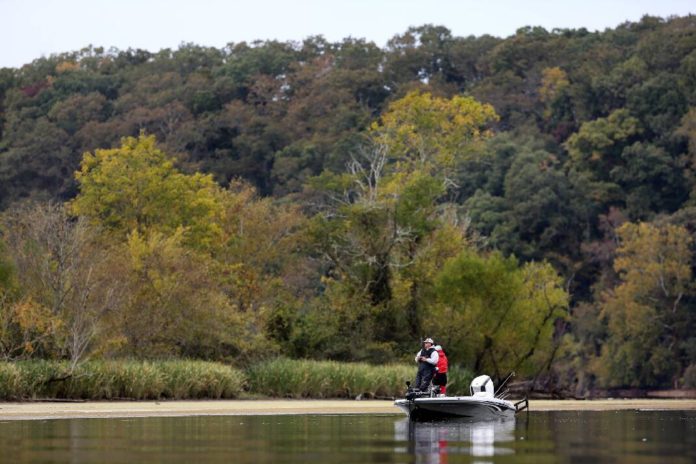Watch video on Youtube »
With a $15 million investment, Tennessee will become home to 18 Bill Dance Signature Lakes bearing the angler’s stamp of approval — and three of them are in the Chattanooga region.
Chickamauga Lake, Tims Ford Lake and Fall Creek Falls Lake are among those targeted by the project to launch in 2022. Officials hope to increase visitation to the lakes and honor the legacy of Dance, an 81-year-old Tennessee native, according to a news release from the state.
(READ MORE: When hunting trophy largemouth bass, patience and obsessive persistence pay off)
Tennessee is home to about 500,000 acres of lakes, and 1.7 million people from Tennessee and elsewhere fish here, state officials said, citing data from the American Sportfishing Association.
Born and raised in Lynchburg, Tennessee, Dance and agency partners selected the lakes for their ability to be a “destination fishing location” and provide quality fishing fun for avid anglers, amateurs and families. Endorsed by Bill Dance Outdoors, projects slated to begin in 2022 should be near completion by fall of 2024, officials said.
“You know, there’s plenty of good fishing spots in our state if you know where to look for them, governor,” Dance told Lee in a promotional video for the project. “Tennessee’s got everything from big waters to bank fishing.
Photo Gallery
Chickamauga, Tims Ford, Fall Creek Falls among 18 ‘Bill Dance Signature Lakes’ to share $15 million in improvements
Good facilities and a well-managed fishery are the keys to world-class fishing, and the 18 Tennessee lakes in the project fit the bill, he said.
“If I’m going to lend my name, I want anglers of all ages, from experts to amateurs, to have a legendary experience,” Dance said.
The state improvements — above and below the waters’ surface — include increased stocking, habitat and fisheries management, along with improved access for fishing and boating. The collaborative effort among state agencies for wildlife resources, tourism development and environment and conservation aims to establish Tennessee as the heart of fishing in the Southeast and drive economic activity across the state, officials said.
The Bill Dance Signature Lakes project includes nine large reservoirs with a proven track record for quality fishing for a variety of catches. In partnership with the Tennessee Valley Authority, reservoirs will get new or upgraded “best-in-class” ramps to improve public access for recreational and tournament anglers.
Each of the 18 lakes will see such above-water upgrades as courtesy docks, ample parking, additional access points, fishing piers and signs, to name a few of the updates. Several smaller lakes, many of which are located within Tennessee State Parks, will be managed by the Tennessee Wildlife Resources Agency for Bill Dance-approved family fishing with regular stockings to ensure the best chance for success.
(READ MORE: Chattanooga on the fly: A look into the city’s growing fly fishing scene)
The 18 lakes in the project touch 39 counties, including 22 at-risk or economically distressed counties. Officials said the project can create new revenue streams in those communities by increasing visitation. In Tennessee, fishing generates $1.2 billion in economic impact annually and supports 7,480 jobs, the state estimates.
BILL DANCE SIGNATURE LAKES
Tennessee’s 18 Bill Dance Signature Lakes as the project is launched are:
—1,000 Acre Lake in Carroll County.
—Brown’s Creek Lake at Natchez Trace State Park in Henderson County.
—Chickamauga Lake at Harrison Bay State Park and Chester Frost Park in Hamilton, Rhea,
Meigs, McMinn and Bradley counties.
—Dale Hollow Lake in Clay, Pickett, Fentress and Overton counties.
—Douglas Lake in Jefferson, Sevier and Cocke counties.
—Fall Creek Falls Lake at Fall Creek Falls State Park in Van Buren County.
—Herb Parsons Lake in Fayette County.
—Kentucky Lake at Paris Landing State Park in Henry, Stewart, Houston, Benton, Decatur, Perry and Humphreys counties.
—Lake Acorn at Montgomery Bell State Park in Dickson County.
—Lake Woodhaven in Montgomery Bell State Park.
—Norris Lake in Anderson, Campbell, Claiborne, Grainger and Union
counties.
—Old Hickory Lake in Sumner and Davidson counties.
—Pickwick Lake at Pickwick Landing State Park in Hardin County.
—Pin Oak Lake at Natchez Trace State Park in Henderson County.
—Reelfoot Lake at Reelfoot Lake State Park in Lake and Obion counties.
—Tim’s Ford Lake at Tim’s Ford State Park in Franklin and Moore counties.
—Travis McNatt Lake at Big Hill Pond State Park in McNairy County.
—Watauga Lake in Johnson and Carter counties.
Source: Tennessee Department of Environment and Conservation, Tennessee Wildlife Resources Agency and Tennessee Department of Tourist Development
Anglers in Chattanooga want some of the planned improvements but would like to see other problems addressed, too, according to Jack’s Bait & Tackle Shop owner Kim Trotter.
(READ MORE: Study recommends curtains of unpleasant bubbles to fence Asian carp in Tennessee waters)
Local anglers are talking about how the $15 million should be used to prevent shoreline erosion caused by the wakes from large cruisers on Chickamauga, she said Thursday.
Trotter also said customers are concerned about overuse of chemicals in the water to treat weeds.
“What they’re telling me is that they want to stop contracted spraying for grass,” she said. “They’re saying that if it needs to be done, it needs to be done by TVA or TWRA because it has been seen at times these contractors whenever they get done they’re just dumping that leftover spray anywhere.”
Local anglers would like to see the number of commercial fishing guides on the popular Chickamauga Lake regulated because the increased pressure on fish from groups of paying customers is amounting to a great number of anglers fishing the lake at the same time.
“They feel the guides are literally beating the lake to death,” she said, noting some fish are being caught repeatedly.
(READ MORE: Spring’s best bites on the Tennessee River)
“Of course, they would like to see the control of Asian carp. They’re very concerned about that,” she said, running down the list of concerns identified by customers.
“The last thing that was mentioned to me just yesterday is they feel like they should release fry into our area lakes at least once a year to improve the fishing,” she said. That also is among the goals of the lakes project.
“Several years ago a Florida strain of [large mouth bass] fry was released and when they did that it improved the population tremendously,” she said of the new strain that is producing huge catches on Chickamauga.
(READ MORE: Scenic City Fishing Charters gets anglers hooked on the Tennessee River)
She understands anglers, including commercial guides and their customers, want to fish, and there are only so many bodies of water.
Anglers “are like our family and we want to give them the best, and we like to sit and talk with them and find out what their concerns are to see if there is anything we can do to help them,” she said. “It’s not all about selling bait and tackle, you know what I mean?”
Contact Ben Benton at bbenton@timesfreepress.com or 423-757-6569. Follow him on Twitter @BenBenton.
FISHING ACROSS THE U.S.
According to the American Sportfishing Association’s 2021 Special Report on Fishing, an impressive 54.7 million Americans fished at least once in 2020, the highest number recorded since participation tracking began in 2007. Fishing participation rose to 18% of the U.S. population, the highest rate in over a decade and a nearly 9% gain versus 2019.
Despite the higher number of anglers and the increased participation rate, the frequency of fishing trips continued its long-term decline.
In 2020, the average number of outings per participant was 18 trips, down from 22 in 2008. This declining intensity means there are fewer of the most devoted anglers and more casual ones. Nonetheless, a “COVID bounce” clearly brought new energy to fishing, according to the association, as total outings rose to 969 million. This represented the highest number of outings since 2012 and a 10% increase from the year before.
Other trends noted in the report’s executive summary:
*Youth and adolescent fishing participation rose sharply in 2020. Eight million children ages 6-12 fished, a one year increase of 15%.
*Fishing among Hispanic Americans continued to grow. Hispanics participated in fishing at a rate of 13% in 2020, the highest recorded in the Special Report on Fishing.
*Encouraging news about female anglers was abundant in 2020. Nearly 1.8 million more women fished than in the year prior, a 10% increase.
*Data continues to underscore the critical importance of introducing fishing at a young age, as 88% of current fishing participants fished before the age of 12. Participation rates among young anglers fall by about half after the age of 12, making families with young children the key to growing future participation.
Source: American Sportfishing Association
Credit: Source link































